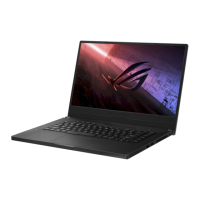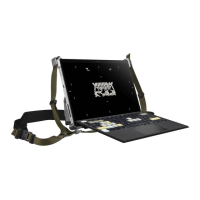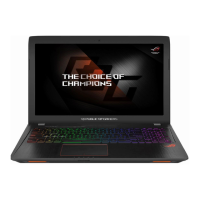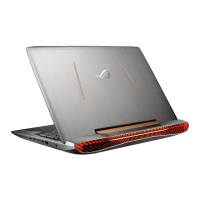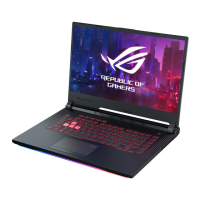Do you have a question about the Asus ROG Zephyrus G14 and is the answer not in the manual?
Legal terms regarding manual reproduction and ASUS liability, defining user rights and restrictions.
Details ASUS's liability limits for product issues and damages, specifying exclusions and responsibilities.
Information on how to obtain technical assistance and find the ASUS support website for multi-language help.
An overview of the Notebook PC's external design, identifying key components on the top view.
Identifies and describes the components located on the bottom surface of the Notebook PC.
Details the ports and connectors available on the right side of the Notebook PC.
Details the ports and connectors available on the left side of the Notebook PC.
Explains the function and meaning of various status lights on the Notebook PC.
Describes the keyboard layout, keys, and its general functionality for typing and shortcuts.
Instructions on how to use the power button for turning the PC on/off, sleep, and shutdown.
Describes the touchpad and its multi-gesture capabilities for navigation and interaction.
Explains the function of air vents for cooling and warns about potential obstructions.
Details the specifications and usage of various USB ports and the HDMI port.
Information on the audio jack and the multi-functional USB-C combo port.
Initial setup steps including charging the Notebook PC's battery before first use.
Instructions on how to open the display panel and press the power button.
Details on moving the pointer and using one-finger, two-finger, and three-finger gestures.
Explains two-finger scrolling, zooming, and three-finger tap gestures for enhanced control.
Instructions for using three-finger swipes to switch apps, view overview, and show the desktop.
Details on four-finger gestures and steps to customize touchpad settings for user preference.
Explains the usage of function keys, Fn key combinations, and keyboard backlight control.
Describes the functionality of special Windows keys for launching the Start menu and other actions.
Steps for initial configuration of Windows 10 on the Notebook PC.
Guide to launching the Start menu and opening programs from it.
Information on launching, customizing, moving, resizing, and pinning Windows apps.
How to use Task view for multitasking and the Snap feature for arranging windows side-by-side.
How to access and utilize the Action Center for notifications and quick actions.
A list of useful keyboard shortcuts for navigating and performing actions in Windows 10.
Steps for connecting to Wi-Fi networks and pairing Bluetooth-enabled devices.
Instructions on how to enable and disable Airplane mode for safe in-flight usage.
Procedures for properly shutting down the Notebook PC or putting it into sleep mode.
Overview of the Power-On Self-Test (POST) diagnostic tests and accessing BIOS settings.
Methods to enter the BIOS setup for system configuration and troubleshooting.
Options for restoring or refreshing the Notebook PC's system, including keeping files or removing everything.
Steps to access advanced startup options and perform system recovery or restore actions.
Brief descriptions of the content covered in each chapter of the manual.
Introduction to the sections providing useful tips, hardware, and software frequently asked questions.
Introduction to the appendices, covering notices and safety statements.
Explains conventions like IMPORTANT!, NOTE:, and WARNING! for highlighting key information.
Defines the meaning of icons and text formatting conventions used throughout the manual.
Essential safety guidelines for operating the Notebook PC in various environments and conditions.
Guidelines for safely cleaning the Notebook PC, avoiding damage from liquids or chemicals.
Instructions on how to properly dispose of the Notebook PC and its battery according to regulations.
Tips for maximizing system performance, data security, and general usage of the Notebook PC.
Answers to common questions regarding display, battery, touchpad, and power adapter issues.
Solutions for common software issues like blank screens, boot errors, and system performance lags.
Information on display compliance, FCC, ISED, UL safety, and environmental regulations like RoHS.
Details on internal modem compliancy, network compatibility, and CTR 21 approval.
Cautions regarding lithium-ion batteries and services for rechargeable battery recycling.
Declaration of compliance with relevant EU directives for the device.
| Processor | AMD Ryzen 9 5900HS |
|---|---|
| Graphics | NVIDIA GeForce RTX 3060 |
| RAM | 16GB DDR4 |
| Battery | 76Wh |
| Operating System | Windows 10 Home |
| Wireless | Wi-Fi 6 (802.11ax), Bluetooth 5.1 |
| Display | 14-inch, QHD (2560 x 1440), 120Hz |
| Storage | 1TB NVMe SSD |
| Weight | 1.7 kg |
| Dimensions | 324 x 222 x 19.9 mm |
| Audio | Dolby Atmos, Smart Amp Technology |
| Ports | 1x HDMI 2.0b, 2x USB 3.2 Gen 1 Type-A |
